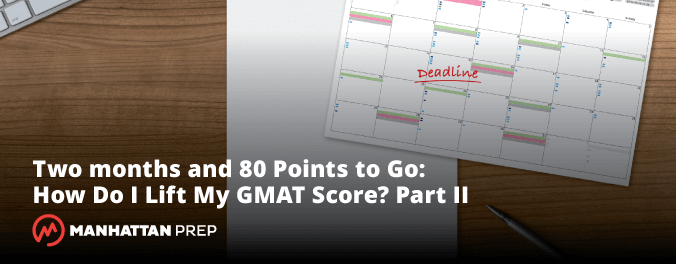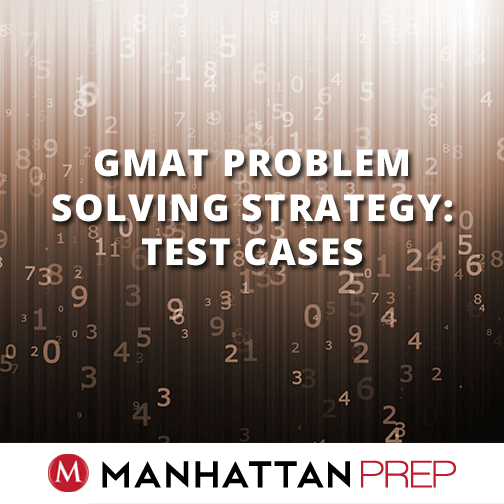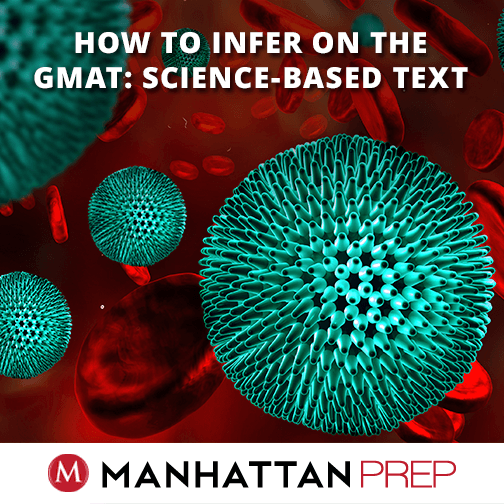Two months and 80 points to go: How do I raise my GMAT score? (Part 2)
 In the first part of this series, we talked about how to analyze your strengths and weaknesses and in which categories of “low hanging fruit” to concentrate your studies.
In the first part of this series, we talked about how to analyze your strengths and weaknesses and in which categories of “low hanging fruit” to concentrate your studies.
We left off talking about timing; let’s talk about how to make better decisions as you take the test. Read more
Two months and 80 points to go: How do I raise my GMAT score? (Part 1)
 Most second-round deadlines are in early January, so around now, a lot of people are asking me how to eke out the last 30 to 80 points they need to reach their goal.
Most second-round deadlines are in early January, so around now, a lot of people are asking me how to eke out the last 30 to 80 points they need to reach their goal.
Let’s talk about what to do to try to lift your score that last bit in the final 2 months of your study.
Is this article for me?
Here’s why you might be missing GMAT Data Sufficiency Problems – Part 1
 Did you know that you can attend the first session of any of our online or in-person GMAT courses absolutely free? We’re not kidding! Check out our upcoming courses here.
Did you know that you can attend the first session of any of our online or in-person GMAT courses absolutely free? We’re not kidding! Check out our upcoming courses here.
Let’s talk about GMAT Data Sufficiency.
Specifically, let’s talk about getting GMAT Data Sufficiency (DS) problems wrong. And I don’t mean those problems that you missed because of careless math errors, or because of concepts you hadn’t learned yet. No, I’m talking about the missed DS problems that make you want to bang your head against the wall: How on Earth did I not get that?
There are two reasons you might have this experience: Read more
The Importance of Getting to No on the GMAT — Part 1
 Recently, a colleague of mine shared this very interesting puzzle published by the New York Times. (Thanks, Ceilidh!)
Recently, a colleague of mine shared this very interesting puzzle published by the New York Times. (Thanks, Ceilidh!)
Go ahead and try it. I’ll wait. After you’ve tried the puzzle, you can read the short article that goes with it.
What did you learn about how humans tend to think? More important, what did you learn about how you think?
That tendency to look for the no, or to try to disprove something, is a trait shared by scientists, devil’s advocates, and great standardized test takers. You can learn to make this your natural reaction, too!
GMAT Problem Solving Strategy: Test Cases
 If you’re going to do a great job on the GMAT, then you’ve got to know how to Test Cases. This strategy will help you on countless quant problems.
If you’re going to do a great job on the GMAT, then you’ve got to know how to Test Cases. This strategy will help you on countless quant problems.
This technique is especially useful for Data Sufficiency problems, but you can also use it on some Problem Solving problems, like the GMATPrep® problem below. Give yourself about 2 minutes. Go!
* “For which of the following functions f is f(x) = f(1 – x) for all x?
| (A) | f(x) = 1 – x |
| (B) | f(x) = 1 – x2 |
| (C) | f(x) = x2 – (1 – x)2 |
| (D) | f(x) = x2(1 – x)2 |
| (E) | f(x) = x / (1 – x)” |
Testing Cases is mostly what it sounds like: you will test various possible scenarios in order to narrow down the answer choices until you get to the one right answer. What’s the common characteristic that signals you can use this technique on problem solving?
The most common language will be something like “Which of the following must be true?” (or “could be true”).
The above problem doesn’t have that language, but it does have a variation: you need to find the answer choice for which the given equation is true “for all x,” which is the equivalent of asking for which answer choice the given equation is always, or must be, true.
Read more
Free Webinar Series: 5 Steps to Your Dream MBA
Are You Prepared for B-School Admissions?

Join Manhattan GMAT and two other leaders in the MBA admissions space— mbaMission and MBA Career Coaches
—for an invaluable series of free workshops to help you put together a successful MBA application, from your GMAT score to application essays to admissions interviews to post-acceptance internships. We hope you will join us for as many events in this series as you can. Please sign up for each sessions separately via the links below—space is limited.
Session 1: Assessing Your MBA Profile and GMAT vs. GRE
Tuesday, March 24, 2015 (7:30- 9:00 PM EDT) SIGN UP HERE
Session 2: Selecting Your Target MBA Program and How
to Study for the GMAT in Two Weeks
Tuesday, March 31, 2015 (7:30- 9:00 PM EDT) SIGN UP HERE
Session 3: Writing Standout B-School Admissions Essays
and Advanced GMAT: 700+ Level Sentence Correction
Tuesday, April 7, 2015 (7:30- 9:00 PM EDT) SIGN UP HERE
Session 4: Five Pre-MBA Steps to Landing Your Dream Internship and
Advanced GMAT: 700+ Level Quant Strategy
Tuesday, April 14, 2015 (7:30- 9:00 PM EDT) SIGN UP HERE
Session 5: Questions and Answers with MBA Admissions Officers
Tuesday, April 21, 2015 (7:30- 9:00 PM EDT) SIGN UP HERE
Want a Better GMAT Score? Go to Sleep!
 This is going to be a short post. It will also possibly have the biggest impact on your study of anything you do all day (or all month!).
This is going to be a short post. It will also possibly have the biggest impact on your study of anything you do all day (or all month!).
When people ramp up to study for the GMAT, they typically find the time to study by cutting down on other activities—no more Thursday night happy hour with the gang or Sunday brunch with the family until the test is over.
There are two activities, though, that you should never cut—and, unfortunately, I talk to students every day who do cut these two activities. I hear this so much that I abandoned what I was going to cover today and wrote this instead. We’re not going to cover any problems or discuss specific test strategies in this article. We’re going to discuss something infinitely more important!
#1: You must get a full night’s sleep
Period. Never cut your sleep in order to study for this test. NEVER.
Your brain does not work as well when trying to function on less sleep than it needs. You know this already. Think back to those times that you pulled an all-nighter to study for a final or get a client presentation out the door. You may have felt as though you were flying high in the moment, adrenaline coursing through your veins. Afterwards, though, your brain felt fuzzy and slow. Worse, you don’t really have great memories of exactly what you did—maybe you did okay on the test that morning, but afterwards, it was as though you’d never studied the material at all.
There are two broad (and very negative) symptoms of this mental fatigue that you need to avoid when studying for the GMAT (and doing other mentally-taxing things in life). First, when you are mentally fatigued, you can’t function as well as normal in the moment. You’re going to make more careless mistakes and you’re just going to think more slowly and painfully than usual.
Read more
When Your High School Algebra is Wrong: How the GMAT Breaks Systems of Equations Rules
 If you have two equations, you can solve for two variables.
If you have two equations, you can solve for two variables.
This rule is a cornerstone of algebra. It’s how we solve for values when we’re given a relationship between two unknowns:
If I can buy 2 kumquats and 3 rutabagas for $16, and 3 kumquats and 1 rutabaga for $9, how much does 1 kumquat cost?
We set up two equations:
2k + 4r = 16
3k + r = 9
Then we can use either substitution or elimination to solve. (Try it out yourself; answer* below).
On the GMAT, you’ll be using the “2 equations à 2 variables” rule to solve for a lot of word problems like the one above, especially in Problem Solving. Be careful, though! On the GMAT this rule doesn’t always apply, especially in Data Sufficiency. Here are some sneaky exceptions to the rule…
2 Equations aren’t always 2 equations
Read more
Tackling Max/Min Statistics on the GMAT (part 3)

Welcome to our third and final installment dedicated to those pesky maximize / minimize quant problems. If you haven’t yet reviewed the earlier installments, start with part 1 and work your way back up to this post.
I’d originally intended to do just a two-part series, but I found another GMATPrep® problem (from the free tests) covering this topic, so here you go:
“A set of 15 different integers has a median of 25 and a range of 25. What is the greatest possible integer that could be in this set?
“(A) 32
“(B) 37
“(C) 40
“(D) 43
“(E) 50”
Here’s the general process for answering quant questions—a process designed to make sure that you understand what’s going on and come up with the best plan before you dive in and solve:

Fifteen integers…that’s a little annoying because I don’t literally want to draw 15 blanks for 15 numbers. How can I shortcut this while still making sure that I’m not missing anything or causing myself to make a careless mistake?
Hmm. I could just work backwards: start from the answers and see what works. In this case, I’d want to start with answer (E), 50, since the problem asks for the greatest possible integer.
Read more
How to Infer on the GMAT
 We’re going to kill two birds with one stone in this week’s article.
We’re going to kill two birds with one stone in this week’s article.
Inference questions pop up on both Critical Reasoning (CR) and Reading Comprehension (RC), so you definitely want to master these. Good news: the kind of thinking the test-writers want is the same for both question types. Learn how to do Inference questions on one type and you’ll know what you need to do for the other!
That’s actually only one bird. Here’s the second: both CR and RC can give you science-based text, and that science-y text can get pretty confusing. How can you avoid getting sucked into the technical detail, yet still be able to answer the question asked? Read on.
Try this GMATPrep® CR problem out (it’s from the free practice tests) and then we’ll talk about it. Give yourself about 2 minutes (though it’s okay to stretch to 2.5 minutes on a CR as long as you are making progress.)
“Increases in the level of high-density lipoprotein (HDL) in the human bloodstream lower bloodstream cholesterol levels by increasing the body’s capacity to rid itself of excess cholesterol. Levels of HDL in the bloodstream of some individuals are significantly increased by a program of regular exercise and weight reduction.
“Which of the following can be correctly inferred from the statements above?
“(A) Individuals who are underweight do not run any risk of developing high levels of cholesterol in the bloodstream.
“(B) Individuals who do not exercise regularly have a high risk of developing high levels of cholesterol in the bloodstream late in life.
“(C) Exercise and weight reduction are the most effective methods of lowering bloodstream cholesterol levels in humans.
“(D) A program of regular exercise and weight reduction lowers cholesterol levels in the bloodstream of some individuals.
“(E) Only regular exercise is necessary to decrease cholesterol levels in the bloodstream of individuals of average weight.”
Got an answer? (If not, pick one anyway. Pretend it’s the real test and just make a guess.) Before we dive into the solution, let’s talk a little bit about what Inference questions are asking us to do.
Inference questions are sometimes also called Draw a Conclusion questions. I don’t like that title, though, because it can be misleading. Think about a typical CR argument: they usually include a conclusion that is…well…not a solid conclusion. There are holes in the argument, and then they ask you to Strengthen it or Weaken it or something like that.
Read more